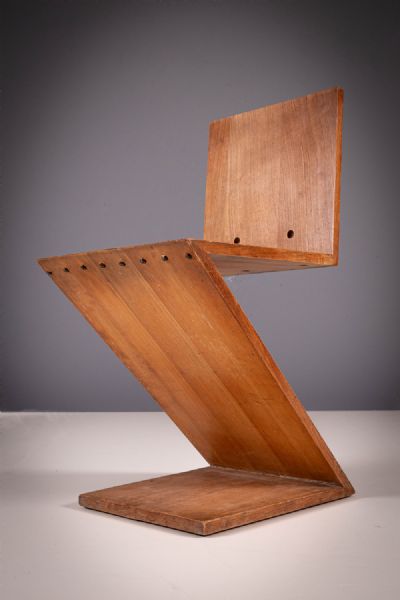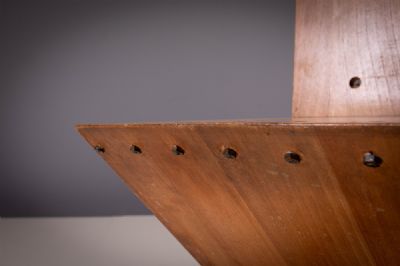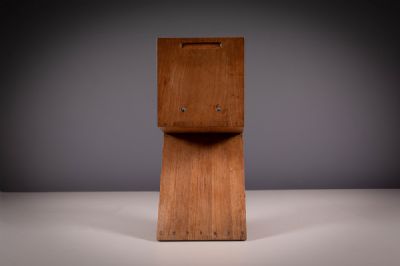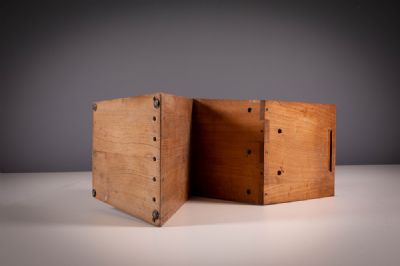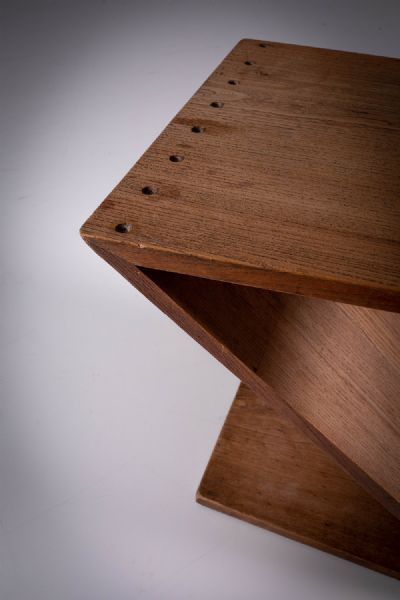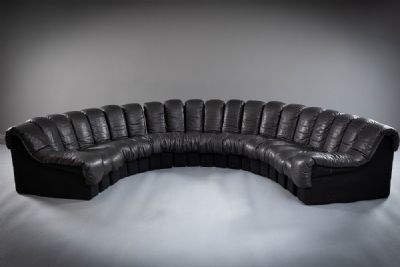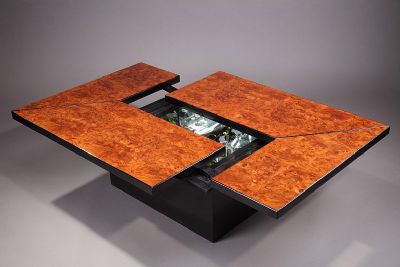Bidding on this item has ended.
GERRIT RIETVELD
THE ZIG-ZAG CHAIR
Lot 28
Price Realised:
€9,000
Estimate:
€8,000 - €12,000
Gerrit Thomas Rietveld, 1888-1964
THE ZIG-ZAG CHAIR
Elm, 74cm (h) x 37cm (w) x 40cm (d).
Provenance: This chair was bought in the early 1960s by a friend of the present owners father. At that time, he was working for the graphic designer Willem ...
Read more
 Lot 28
GERRIT RIETVELD
THE ZIG-ZAG CHAIR
Lot 28
GERRIT RIETVELD
THE ZIG-ZAG CHAIR
 Lot 28
GERRIT RIETVELD
THE ZIG-ZAG CHAIR
Lot 28
GERRIT RIETVELD
THE ZIG-ZAG CHAIR
Estimate:
€8,000 - €12,000
Gerrit Thomas Rietveld, 1888-1964
THE ZIG-ZAG CHAIR
Elm, 74cm (h) x 37cm (w) x 40cm (d).
Provenance: This chair was bought in the early 1960s by a friend of the present owners father. At that time, he was working for the graphic designer Willem Sandberg in the Netherlands. Sandberg and Rietveld were close friends and had lunch every Friday. On seeing the chair, the previous owner enquired as to whether it was for sale. Rietveld, who made several models per year in order to keep his hand in the production business, stated he did not normally sell these pieces but would part with it for £7, the price of the wood. The chair was then acquired by the present owners father in the early 1970s for £10.
The Zig-Zag was originally designed by Gerrit Rietveld in 1934 and quickly deemed a design icon, being one of the first examples of a cantilevered solid wood chair, formed by four flat pieces of wood joined in rhythmic sequence to create an extremely sophisticated appearance of instability.
"It is not a chair but a designer joke," Rietveld famously said of the piece that would, ironically, become perhaps his most recognizable chair design. Introduced in 1934, the Zig-Zag chair was the result of Dutch department store Metz & Co having enlisted Rietveld to create a chair for mass production.
By this time, Rietveld had gained international acclaim for designs like his famous Red and Blue chair as well as the ground-breaking Rietveld Schröder House (1924) in his native Utrecht (now a UNESCO World Heritage Site), where he had brought to life many of the ideals of abstraction espoused in the De Stijl ("the Style") movement. By the late 1920s, though, the designer had largely abandoned De Stijl in favor of a new movement, Nieuwe Zakelijkheid, or "New Pragmatism," which aligned with other modernist movements for its emphasis on functionality and eschewing of ornamentation. Rietveld began experimenting with alternative, inexpensive materials like plywood and concrete. Metz & Co's request for a simple seat, then, would seem a good fit.
In the form of the Zig-Zag chair, Rietveld delivered one of the earliest examples of a cantilevered seat. Unlike cantilevered models by Ludwig Mies van der Rohe and Marcel Breuer, however, Rietveld's didn't rely on a metal frame. In fact, the Zig-Zag chair is constructed completely from wood, its graphic shape a result of exceptionally precise craftsmanship. Rietveld hoped to produce a chair from one continuous piece of material; while the Zig-Zag doesn't quite achieve that, it appears to: The seat's four parts are connected by dovetail joints made from the same wood as the rest of the chair. As a result, the final product appears deceptively simple — despite the carefully calibrated measurement and engineering that goes into its shape, it has the semblance of precariousness.
Rietveld would go on to devise various versions of the seat, including a beloved high chair for children, as his career developed into more of an architect's than that of a furniture designer. This chair is a version, possibly experimental, to test the chair manufacture without the horizontal lats that support the joins.
In 1971, Italian manufacturer Cassina bought the rights to the Zig-Zag chair and has been producing it ever since, even offering it in a selection of primary colored finishes, which harken back to Rietveld's De Stijl days. The chair's famous fans include artist Donald Judd and designer Karl Lagerfeld, and it sits in the permanent collection of the Museum of Modern Art.
THE ZIG-ZAG CHAIR
Elm, 74cm (h) x 37cm (w) x 40cm (d).
Provenance: This chair was bought in the early 1960s by a friend of the present owners father. At that time, he was working for the graphic designer Willem Sandberg in the Netherlands. Sandberg and Rietveld were close friends and had lunch every Friday. On seeing the chair, the previous owner enquired as to whether it was for sale. Rietveld, who made several models per year in order to keep his hand in the production business, stated he did not normally sell these pieces but would part with it for £7, the price of the wood. The chair was then acquired by the present owners father in the early 1970s for £10.
The Zig-Zag was originally designed by Gerrit Rietveld in 1934 and quickly deemed a design icon, being one of the first examples of a cantilevered solid wood chair, formed by four flat pieces of wood joined in rhythmic sequence to create an extremely sophisticated appearance of instability.
"It is not a chair but a designer joke," Rietveld famously said of the piece that would, ironically, become perhaps his most recognizable chair design. Introduced in 1934, the Zig-Zag chair was the result of Dutch department store Metz & Co having enlisted Rietveld to create a chair for mass production.
By this time, Rietveld had gained international acclaim for designs like his famous Red and Blue chair as well as the ground-breaking Rietveld Schröder House (1924) in his native Utrecht (now a UNESCO World Heritage Site), where he had brought to life many of the ideals of abstraction espoused in the De Stijl ("the Style") movement. By the late 1920s, though, the designer had largely abandoned De Stijl in favor of a new movement, Nieuwe Zakelijkheid, or "New Pragmatism," which aligned with other modernist movements for its emphasis on functionality and eschewing of ornamentation. Rietveld began experimenting with alternative, inexpensive materials like plywood and concrete. Metz & Co's request for a simple seat, then, would seem a good fit.
In the form of the Zig-Zag chair, Rietveld delivered one of the earliest examples of a cantilevered seat. Unlike cantilevered models by Ludwig Mies van der Rohe and Marcel Breuer, however, Rietveld's didn't rely on a metal frame. In fact, the Zig-Zag chair is constructed completely from wood, its graphic shape a result of exceptionally precise craftsmanship. Rietveld hoped to produce a chair from one continuous piece of material; while the Zig-Zag doesn't quite achieve that, it appears to: The seat's four parts are connected by dovetail joints made from the same wood as the rest of the chair. As a result, the final product appears deceptively simple — despite the carefully calibrated measurement and engineering that goes into its shape, it has the semblance of precariousness.
Rietveld would go on to devise various versions of the seat, including a beloved high chair for children, as his career developed into more of an architect's than that of a furniture designer. This chair is a version, possibly experimental, to test the chair manufacture without the horizontal lats that support the joins.
In 1971, Italian manufacturer Cassina bought the rights to the Zig-Zag chair and has been producing it ever since, even offering it in a selection of primary colored finishes, which harken back to Rietveld's De Stijl days. The chair's famous fans include artist Donald Judd and designer Karl Lagerfeld, and it sits in the permanent collection of the Museum of Modern Art.
- Enquire
- View all lots by this artist
- How bidding works
Please note: You will require a deVeres account in order to bid. Please register via the website. Each lot will close numerically. If there is late bidding the time may be extended which could delay subsequent lots. The lots will start to close from 2.00pm on auction day, closing at 45 second intervals.
PLEASE BID EARLY TO AVOID DISAPPOINTMENT.
In order to allow rival bidders the opportunity to respond to a late bid the following extensions will apply:
IF A BID IS RECEIVED WITHIN THE FINAL 45 SECONDS OF THE COUNTDOWN THE CLOCK WILL RESET TO 60 SECONDS.
At any point you can leave a maximum bid, representing the highest price you are prepared to pay for a particular lot. Bidding only advances when there is competition from a rival bidder. In that case the system bids on your behalf, only up to the maximum if required. All bids are relayed to you be email, along with notification if you have been outbid.
All maximum bids are confidential and not disclosed. The system will endeavor to purchase the lot for you for the least price. Bids are subject to buyer’s premium of 25% (incl vat), with no additional charges.
In the event of a tied bid, the preference will be given to the bid submitted first. The second bidder will receive immediate notification of being outbid.
PLEASE BID EARLY TO AVOID DISAPPOINTMENT.
In order to allow rival bidders the opportunity to respond to a late bid the following extensions will apply:
IF A BID IS RECEIVED WITHIN THE FINAL 45 SECONDS OF THE COUNTDOWN THE CLOCK WILL RESET TO 60 SECONDS.
At any point you can leave a maximum bid, representing the highest price you are prepared to pay for a particular lot. Bidding only advances when there is competition from a rival bidder. In that case the system bids on your behalf, only up to the maximum if required. All bids are relayed to you be email, along with notification if you have been outbid.
All maximum bids are confidential and not disclosed. The system will endeavor to purchase the lot for you for the least price. Bids are subject to buyer’s premium of 25% (incl vat), with no additional charges.
In the event of a tied bid, the preference will be given to the bid submitted first. The second bidder will receive immediate notification of being outbid.
Sign-up to our auction alert
Signup for personalised Irish art recommendations, invitations to viewings and auctions, articles and more.

